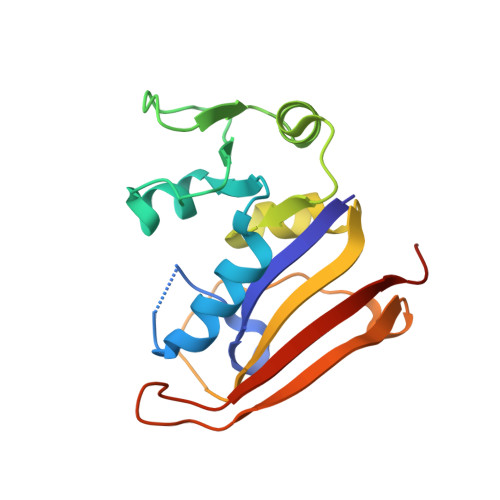Time-resolved x-ray crystallography capture of a slow reaction tetrahydrofolate intermediate.
Cao, H., Skolnick, J.(2019) Struct Dyn 6: 024701-024701
- PubMed: 30868089
- DOI: https://doi.org/10.1063/1.5086436
- Primary Citation of Related Structures:
6MR9, 6MT8, 6MTH - PubMed Abstract:
Time-resolved crystallography is a powerful technique to elucidate molecular mechanisms at both spatial (angstroms) and temporal (picoseconds to seconds) resolutions. We recently discovered an unusually slow reaction at room temperature that occurs on the order of days: the in crystalline reverse oxidative decay of the chemically labile (6S)-5,6,7,8-tetrahydrofolate in complex with its producing enzyme Escherichia coli dihydrofolate reductase. Here, we report the critical analysis of a representative dataset at an intermediate reaction time point. A quinonoid-like intermediate state lying between tetrahydrofolate and dihydrofolate features a near coplanar geometry of the bicyclic pterin moiety, and a tetrahedral sp 3 C6 geometry is proposed based on the apparent mFo-DFc omit electron densities of the ligand. The presence of this intermediate is strongly supported by Bayesian difference refinement. Isomorphous Fo-Fo difference map and multi-state refinement analyses suggest the presence of end-state ligand populations as well, although the putative intermediate state is likely the most populated. A similar quinonoid intermediate previously proposed to transiently exist during the oxidation of tetrahydrofolate was confirmed by polarography and UV-vis spectroscopy to be relatively stable in the oxidation of its close analog tetrahydropterin. We postulate that the constraints on the ligand imposed by the interactions with the protein environment might be the origin of the slow reaction observed by time-resolved crystallography.
- Center for the Study of Systems Biology, School of Biological Sciences, Georgia Institute of Technology, 950 Atlantic Drive, NW, Atlanta, Georgia 30332, USA.
Organizational Affiliation:



















